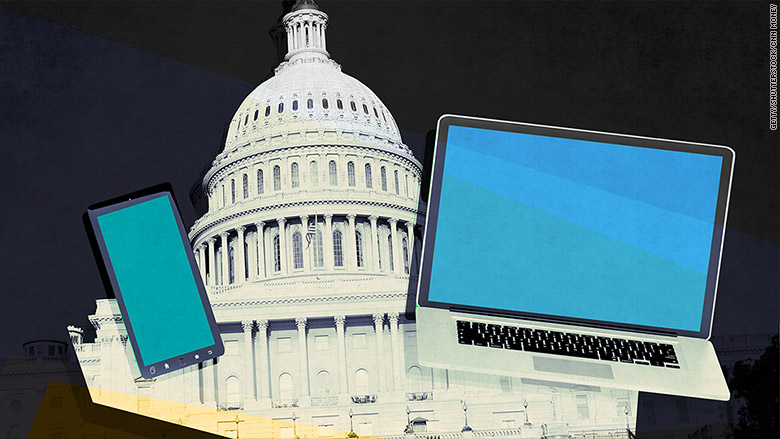
Nancy Edwards is using President Donald Trump's favorite site to push back against his policies.
The 72-year-old Colorado grandmother is using the anonymous Twitter account @ndejde to speak out against Trump and reply to Republican leadership.
"I've taken to Twitter with a vengeance," Edwards said. "I'm really a nasty woman on there."
Though she has a small following, Edwards doesn't pull any punches when replying to tweets from the president or other conservative politicians like Colorado Senator Cory Gardner and former Alaska governor Sarah Palin.
Edwards is one of many newly engaged Americans who have started using free online tools to educate themselves on Trump's policies and advocate against them. She logged in to her long-abandoned Twitter account soon after Trump was elected. She says she follows accounts from both sides of the political spectrum in an effort to better understand the political divide in the U.S.
She says the replies she sometimes receives from Trump supporters are "very hateful and angry," so she doesn't engage with them.
She uses Twitter (TWTR) and Facebook (FB) to find out about protests and other advocacy events. Some of the vitriol she receives online is experienced offline, too -- in Boulder, a man called her Women's March sign "piss-poor."
The sign said "TWO WEEKS/TOO LONG/TOPPLE TRUMP!" She laughed at him.
"It's a dark moment in our history," Edwards said. "And I'm not sure what I can do about it but write and call and tweet."
Jack Dorsey: Twitter shows best and worst of democracy
Resources like the Indivisible Guide, 5 Calls, and Swing Left have sprung up since Trump's election to promote civic engagement with simple, step-by-step instructions on what people can try to do to actually affect change.
It's not the first time we've seen technology play a role in getting people politically motivated. President Barack Obama leveraged tech outreach in both the 2008 and 2012 elections. Tea Party activists hosted workshops at the 2012 Republican National Convention to teach supporters how to use social media tools as it became clear they were essential for political activism.
Trump himself has been a master of social media -- he used Twitter exhaustively during the campaign to defend himself, promote his policies and attack his opponents. Since being sworn in, he shows no sign of abandoning the platform as a way to mobilize supporters and communicate directly with the public.
Even Trump isn't enough to fix Twitter's problems
His supporters, too, have gravitated to Twitter to participate in hashtag activism. After the Super Bowl, Trump backers called for a Budweiser boycott for its ad featuring the story of founder and immigrant Adolphus Busch. Conservative Twitter users have also said they will boycott Nordstrom for pulling Ivanka Trump's merchandise from its stores. Pro-Trump supporters have also found a community in subreddits like r/The_Donald and r/altright to share news and information about the administration. However, Reddit banned r/altright last week for violating its content policies.
Sociology professor Dana R. Fisher, director of Program for Society and the Environment at the University of Maryland, said there's no question technology is playing an unprecedented role in getting people involved -- particularly on the left.
"In a lot of ways, people see the very beginning of the Trump administration as an attack on a whole bunch of progressive ideals," Fisher said. "You have the whole progressive movement working together in ways you have not seen since the 1960s and 1970s."
Fisher has studied protests since 2000, and says people are now mobilizing at unusual levels. For instance, results of one survey taken at the Women's March in Washington found that 33% of people had never participated in a protest before, and 56% said it was their first one in the last five years.
The Twitter resistance: Fighting Trump one tweet at a time
For Jonathan Jordan, creating his own project helped him become more active in politics. Each day, he posts a new activity on 100Acts100Days, which he launched three days after Trump took office. He's advocated for opposing Steve Bannon's appointment to the National Security Council, finding a town hall meeting that a legislator will be at, and calling Paul Ryan for a phone poll regarding the Affordable Care Act.
"I found that most people I knew had never really participated in political activism, myself included, and didn't really know where to start," Jordan said. "There was so much information coming at them, so many causes to work on, and they had no experience of what to do even if they wanted to contribute."
From calling their congressional representatives to protesting at City Halls, online manuals and social networks are fueling real-life action.
Last week, Senator Brian Schatz (D-Hawaii) said constituent calls have been pouring into the Capitol at almost twice the usual rate. The Senate received upwards of 1.5 million calls per day, according to data from Senate Minority Leader Chuck Schumer's technical staff. Many of them opposed the nomination of Betsy DeVos as education secretary.
Those calls may be inspired in part by 5Calls. The volunteer project provides scripts for people to call representatives and voice opposition to current issues. The site uses location data to give you the name and phone number of your congressional representatives.
According to 5Calls, it takes about five minutes to make five calls on issues ranging from cabinet nominations to the proposed border wall. Callers are asked to enter the result of the call as "unavailable," "left voicemail" or "made contact." So far, they say, people have made over 400,000 calls assisted by 5Calls.
"People come to us on Twitter and say, 'I've never called before because I didn't know who to call or what to say,'" creator Nick O'Neill said. "By providing this little script, we've enabled them to have the content to speak with their representatives."
The most calls have come from California, New York and Pennsylvania, O'Neill said, adding that Facebook is by far the site's biggest traffic driver.
The women behind the Women's March on Washington
New sources for civic engagement rely on stalwarts of social media to distribute information to millions.
Jessica Gottlieb's living room is a political planning headquarters, organized through a private Facebook group. The Los Angeles mom and blogger regularly hosts a group of 10 women who came together after they, and millions of people around the world, participated in the Women's March.
Gottlieb and her group follow the Indivisible Guide, an online guide written by former congressional staffers that teaches people how to organize and convince local members of Congress to reject Trump's policies.
They plan to focus lobbying efforts on city and state representatives, and although Los Angeles and California are overwhelmingly liberal, there is still work to be done, Gottlieb said. One important issue for Gottlieb is keeping Los Angeles as a sanctuary city for undocumented immigrants. The Trump administration wants to cut federal funding from sanctuary cities.

The Indivisible Guide has been downloaded one million times since December.
Swing Left, another grassroots effort, tracks districts in which conservative House members won by a small margin. When you sign in with your zip code, the site alerts you to the closest swing districts are that are currently held by a conservative. The goal is to flip those districts to progressive representatives in 2018.
Since launching on January 19, the day before Trump's inauguration, nearly 300,000 people have signed up to support their closest swing district, according to spokeswoman Michelle Finocchi. More than 13,000 people from all 52 swing districts have applied to be a District Leader and manage local efforts to elect progressive candidates.
"The response totally surpassed our expectations," Finocchi said. "It's been thrilling, and humbling."

